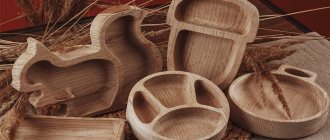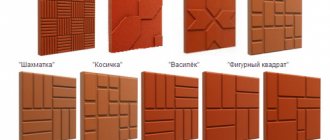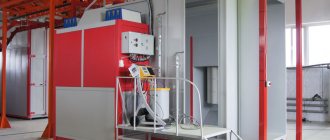My God, just like in a fairy tale: “The blacksmith took a hammer, swung it and hit the anvil...” However, this is not a fairy tale, but reality. Blacksmithing is not forgotten today, although there are probably not enough skilled blacksmiths.
But the demand is simply amazing. What beautiful fences you can order, fireplace grates, window bars. And the gates are truly amazing, although a little expensive. But beauty requires sacrifice.
Where it all started
My name is Bobunin Andrey Vladimirovich. I live in Sergiev Posad. At the time the blacksmiths opened, I was 22 years old. The business was opened in 2013 and is still operating today, its fifth year. At the time the forge opened, I was in my fifth year at the institute, majoring in engineering.
My entire family, in one way or another, is connected with entrepreneurship in the field of production, so the idea of opening my own business was in my mind from early childhood.
A little about my friend
The first thoughts about opening a forge arose from my friend, a creative person and artist, who later became the main blacksmith in production. His thoughts were always directed towards exotic activities; he was drawn to self-realization in a creative way.
At the age of 18, my friend went to study with a blacksmith famous in our profession. He worked for free for four months, then they started paying him little money. Over the next four years, my friend worked and learned at four different forges, and became quite good at his trade.
Once, in a heartfelt conversation at someone’s birthday, we started talking about starting our own business and not wanting to work for “uncle.” After analyzing our abilities and skills acquired during our studies and work in various fields, we came to the understanding that we could open a forge ourselves, without involving third parties (managers, agents, etc.).
Technical equipment of the forge
Before starting the business, we discussed the distribution of responsibilities. A friend took over the production part, and I took on the organizational share.
Search for premises
I was faced with a number of tasks - first of all, it was necessary to find a suitable premises that would meet our requirements, of which there were many:
- Connection to 380 V network.
- Strength characteristics of the foundation and walls of the building (this was very important, since the forge was equipped with a pneumatic hammer with increased vibration emanating from the working (falling) element).
- Distance from the residential area, for quiet operation of the thermal installation (discharge of smoke into the atmosphere).
- Possibility of drainage for production purposes.
- Tolerable distance from place of residence.
This issue was resolved almost immediately. I found a friend with a suitable room of 100 square meters, with a ceiling height of 3 meters. All of the above requirements were met. Moreover, the rental price was purely symbolic and was not binding for the first term.
Everything you need for work
Next, the question arose regarding the financial support of the business. Since the blacksmith business is based, for the most part, on a competent specialist and his ability to do his job efficiently, there were few costs at first. We found most of what we needed at metal depots, from owners of old garages and friends.
We found most of what we needed at metal depots, from owners of old garages and friends.
To start work it was necessary:
- make a forge (a unit for heating metal);
- weld a high-quality forging table from thick metal so that it does not “sink” over the years;
- find an anvil;
- buy a forging pneumatic hammer.
The anvil was found on an old collective farm, since previously each collective farm had its own forge for repairs and other work. In one of these collective farms, a pneumatic hammer, manufactured in 1963, was found and purchased for 60 thousand rubles, which looked more like scrap metal than a working apparatus, but in the USSR they made it conscientiously.
Electricity was installed for proper operation of the workshop and a hole was dug for an anti-vibration cushion under the hammer. To restore this miracle of technology, we found all the drawings and specifications freely available on the Internet, our engineering education helped, so after just a week of hard work, the first horseshoe came out from under our hammer.
We bought a new Resanta welding machine (ordinary, not professional). When we bought it, we were told that with active use it would burn out in six months, but welding has been working for the 6th year, every day, lives and thrives.
Financial support
We spent no more than 150 thousand rubles on all of the above, taking into account the huge amount of metal purchased for the blacksmith table and forge.
All calculations for the necessary funds to begin with, in general, coincided with the real ones +/- 20 thousand rubles. The money was independently earned and saved; the shortage of 30 thousand rubles was compensated by the parents.
How to build a blacksmith shop with your own hands?
It is best to build a forge from materials that are not susceptible to easy fire:
Layout of equipment in a rural forge.
- bricks;
- cinder block;
- asbestos cement sheets.
If the forge is forced to be located in a building with wooden walls, they must be plastered. The floor in the forge is paved with brick, poured with concrete, or made from a mixture of clay and sand, wetting it and thoroughly compacting it. A garage, shed or utility room in the house is suitable for a locksmith workshop. Cold forging machines can also be placed there, since this method of metal processing does not require the use of open fire.
The area of the room for forging decorative elements can be relatively small and dictated only by the convenience and freedom of movement of the blacksmith.
For the production of small-sized products, the optimal forge area can be considered 16 sq.m.
Tools in the forge: hammers, vices, tongs, sharpening.
Such a workshop makes it possible to place all the necessary equipment under one roof. Welding work should only be carried out outdoors.
When carrying out forging work indoors, it is necessary to ensure sufficient ventilation. A supply and exhaust type forced ventilation device would be ideal. In this case, exhaust equipment is placed above the furnace. The height of the ceilings should not be less than 2.5 m. A forge under a canopy does not need ventilation, but working in it in winter will be quite uncomfortable.
Read also: Capacitor pv content of precious metals
First steps
After solving the technical side of the issue, I was faced with the main problem of this business - the lack of orders.
In this type of business, in my personal subjective opinion, word of mouth advertising works best.
At first, I created a website, groups on social networks, scattered information through free resources and began to wait. Let me remind you that I was 22 years old and had very little experience in sales. So 3 months passed without a single call. At the same time, we equipped and built a blacksmith's room for ourselves.
First season of our production
The first spring of our production has begun, the sales season, as we thought then.
As a result, in the first month of spring they produced and sold one grill, with a net profit of 10 thousand rubles. In the following month, another 15 thousand worth of goods were sold. Thus, we lived until September with an average monthly income of 6-7 thousand rubles.
In September, our production of two people decided to organize and go to the Kulikovo Pole festival, where we planned to exhibit our products and earn good money. Since the forge was working at zero, and often even in the minus, it was decided to borrow money from friends to buy material for making products with subsequent sale at the festival. They borrowed 15 thousand rubles and produced quite a variety of goods, from horseshoes and axes to forged roses. As a result, a total of 15 thousand rubles worth of products were sold, which, minus the effort invested and the cost of fuel for logistics, was not very profitable. We were in the red again.
This period was probably the most difficult in the entire 5 years, the situation was heating up and there was a feeling that it was time to end this idea.
Our morale was finally finished off by a good order for 50 thousand rubles, which we received and safely lost due to a broken hammer. And winter was beginning again, which meant a lull in orders. Each of us went to work, leaving the forge until spring, along the way equipping it in small ways.
What's in demand
Conventionally, forged ones can be divided into simple and difficult to manufacture. Among the simple ones, there is always a demand for household products: bars for windows, for fences, gates and wickets. Fences and gates for cemeteries have always been in great demand. With the development of cottage villages, fireplace sets: poker, scoop, tongs are becoming more and more popular.
Candlesticks, clocks, and lanterns from artistic forging are trending. The forged rose, although very common, continues to remain popular. Artistically made barbecues are highly valued, although such work is seasonal. Also in great demand are the same bars, gates, fences, but artistically designed.
Priorities must be clearly set. The simpler the product, the faster it can be made, and the lower the price of the product is the cost of the craftsman’s work; the cost of the material can reach up to 80%. If the product is complex, creative, original and unique, then the cost of the material is only 30%, and the rest is income. But to make such things you often need expensive equipment, as we wrote about in the previous section.
Let's move on to the most interesting part. If information on how to open a forge can be found without any problems, then the information about the forge is quite closed and is not found in open sources. Perhaps the reason for this is that the niche has not yet been fully occupied and relatively high incomes.
Let's try to calculate the approximate profit of the forge. Let's look at the theory first.
For some of the simplest products (forged fences, peaks, dense curls) the price is not the lowest - from 3,000 to 5,000 rubles. per sq. m.. At the same time, the costs for material, paint, electricity, depreciation of tools will be: 550 rubles. — 600 rub. Plus the salary of the auxiliary workers. We make a profit per square meter. m. 2200 - 4200 rub. Producing 4 m of square forged products per day, we get 8800 - 16800 rubles. For 24 working days 96 m. And 211200 - 403200 rubles. Pretty good, wouldn't you agree?
However, at the initial stage it is more convenient to calculate income not by meters, but by finished products. For example, the net profit from a good and beautiful window grill can be 9,000 rubles. Let's assume that this grating takes 4 hours to produce. Then in an 8-hour working day we make 2 gratings for 18 thousand rubles. Minus 20% for the master = 14.4 thousand rubles. per day, 345.6 thousand rubles. within 24 working days. Of course, there will also be unforeseen expenses, marketing costs, taxes and pension contributions. In addition, it is not always possible to organize a queue of orders.
Now let's turn to practice. If we take the average cost of creating a good forge from 1.5 to 2 million rubles. and the average payback time is 1.5 years, then we get from 100 to 133 thousand rubles per month. Quite a bit. As you can see, practice diverges greatly from theory to a lesser extent.
We would venture to assume that the income is still higher, but competent managers invest part of it in development.
It is this approach that will allow you not only to figure out how to open a forge
, but also how to constantly develop, delight customers with new interesting products, and yourself with high profits.
Awareness of problems and mistakes
The following spring we began touring the area and looking for potential customers. They knocked on doors, left business cards, wrote personal messages to people on social networks and told everyone they knew, at every convenient and inconvenient moment, about our forge.
In the spring we forged roses and barbecues, in the fall - canopies and fences. We began to work at the “will” of the customer, offering specific seasonal products.
The Internet helped with the educational theory of sales - yet in the pile of rubbish, there were useful and effective tips. Sales began to grow, mostly due to acquaintances and people whose doors we knocked on.
Full-fledged business
In the fifth year, we reached a good profit, approximately 70-120 thousand per month per person, in connection with this, it was decided to hire additional workers to expand our production and smoothly move to larger volumes.
A good blacksmith with 20 years of experience in blacksmithing and a young assistant with plumbing experience were hired. Only at this stage did we build a shed for lunch and rest and provide heating using waste machine oil (the technology for creating such heating is freely available).
Advice for aspiring entrepreneurs
In conclusion, I would like to give a couple of tips for beginning entrepreneurs in this area:
- By opening a business with friends, you are deliberately taking the step of reducing productivity at work, since non-work relationships make subordination impossible.
- When calculating the cost of an order, it is necessary to take into account all cost items, not forgetting about coal or gas, electricity, primer, paint, patina and delivery.
- Post information about your activities on free resources, message boards and get to know potential customers as much as possible. Drive around your area and knock on private houses without feeling any embarrassment, because this is what your income depends on. Once we realized this, things took off.
- Customers often don’t know what exactly they want and when, they just sit at their dachas and dream of a beautiful canopy, bench, railing or garden decor. Offer your services, make a folder with sketches or photos of products that you can make (for starters, you can download them from the Internet).
- Everyone makes mistakes at the beginning, and it is better to be two months late than to do it poorly. A quality product is your word of mouth. The delay will quickly be forgotten, but the product will remain.
Basic Rules
There are many men who equipped a small room in a residential building as a forge. Most often they used the bathroom for this, which is completely wrong! A forge is a place where basic fire safety rules must be observed.
Before you start talking about how to make a forge yourself, you should determine a place for it. To do this, the following conditions must be met:
- Premises: separate, located away from a residential building.
- Room area: from 15 m2 and above, depending on the purpose of the work.
- Forge walls: built of wood or brick, covered with plaster.
- Forge floor: any non-combustible material.
- Door opening: outward.
- Additionally: good lighting with insulated electrical wiring, ventilation.
Read also: Cutting attachment for drill
A forge located at home may interfere with the sleep of household members, which should be taken into account before constructing or allocating premises. If the work is planned to be carried out only in the warm season, you should think about equipping a canopy. All the recommendations described above are followed regardless of the type of forge.











